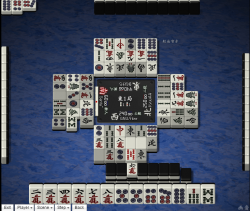Haitei raoyue and houtei raoyui
| Type | Yaku |
|---|---|
| Kanji |
海底撈月 河底撈魚 |
| English |
Win by last draw Win by last discard |
| Value | 1 han |
| Speed | Very Slow |
| Difficulty | Luck |
Haitei raoyue 「海底撈月」 or simply Haitei is a standard yaku, where a player wins with the tsumo on the haiteihai, the last drawable tile from the live wall. As such, this yaku is only accessible via tsumo.
Houtei raoyui 「河底撈魚」 is the ron variant to haitei, which is dependent on the last discarded tile of a hand. So, players making the last discard of the hand must take extra care not to play into another player's hand in this case.
The last tile draw and discard is defined by the dead wall. By rule, the dead wall must retain 14-tiles at all times; and this includes any revealed dora indicators. Naturally, to score either haitei or houtei, a player must be at tenpai at the end of the hand just before ryuukyoku. Finally, hands may definitely be declared for a win, if either haitei or houtei is the only yaku of the hand.
Haiteihai
Haiteihai 「海底牌」 is the very last tile that can be drawn from the regular wall. This is clearly indicated as the 15th tile left, counting the tiles of the dead wall including the dora indicator. Typically, this tile resides as the lower of two tiles next to the back end of the dead wall. Earlier calls for kan may "alter" the designation of the last tile, as that same bottom tile gets shifted into the dead wall to maintain fourteen tiles after the rinshan draw.
Likewise, the very last discard is called houteihai Template:河底牌, which is subject to the call of "ron" for the houtei raoyui yaku and nothing else. Tile calls of chii, pon, or kan cannot apply to it.
Compatability
^ Ippatsu requires riichi to be of any use.
| RCH | DRI | IPP^ | SMO | TAN | PFU | IPK | ITT | YAK | SDJ | SDO | TOI | SNA | SNK | CHA | JUN | RPK | SSG | HRO | HON | CHN | CHI | RIN | HAI | HOU | CHK | |
| HAI | ||||||||||||||||||||||||||
| HOU |
Both yaku are mutually exclusive, as it is impossible to win by draw and by discard at the same time. Houtei cannot combine with mentsumo simply because it is only winnable via discards. As for ippatsu, it is impossible for the riichi caller to have the last discard within one turn.
With rinshan kaihou
Neither yaku cannot be combined with rinshan kaihou, which requires an extra tile draw from from dead wall after a kan.
When winning on the replacement tile after a kan, haitei is applied to a live wall draw but not on a tile from the dead wall. With regards to houtei, the last discarded tile cannot be called to complete melds or be used to form daiminkan (open kans).
Furthermore, per rule, the dead wall must be maintained at 14 tiles. A kan call at the very last tile draw or discard would deny the replenishment of a tile from the regular wall to the dead wall. In other words, forming a kantsu with the very last tile or discard, followed by drawing the rinshanpai, would deplete the dead wall to 13 tiles.
A potential scenario may arise when the second to last tile draw or discard may be legally used to call kan. In turn, that would leave the very last tile from the regular wall to be shifted into the dead wall as the replacement tile. If rinshan kaihou does occur, the rinshanpai could be viewed as the last draw. However, the last draw must come from the regular wall in order to count as haitei. If a tile is discarded instead of calling tsumo win here, that will be the last discard of the game. This last discard may suffice for houtei, to another player, of course.
Setting up haitei raoyue or houtei raoyui

Like any hand, either yaku requires tenpai at the very last draw and/or discard to even have a chance of winning.
External links
- Haitei raoyue in Japanese Wikipedia.
- Houtei raoyui in Japanese Wikipedia.
| |||||||||||||||||||||||||||||||
